Warcraft Retrospective 10: Nobody Expects the Alliance Expedition!
We’re almost finished with Warcraft 2. All that’s left is the human campaign of Beyond the Dark Portal. But since this is my last chance to talk about that game, first I’d like to deal with a couple of topics about Warcraft 2 in general that don’t really fit anywhere specific.
Name’ing
Gul’dan. Ner’zhul. Kil’jaeden. Cho’gall.
Warcraft didn’t start the tradition of apostrophized names. Forgotten Realms used the practice before, with its elves calling themselves Tel’Quessir. Warhammer Fantasy and its evil twin Warhammer 40,000 also make use of such names, and did so before Samwise Didier ever coined the name “Warcraft”.
As far as I can tell, apostrophized names in the Warcraft setting first appeared in Warcraft 2. There were none in Warcraft 1. Their appearance signified the start of Warcraft’s journey towards being a pulp fantasy setting, and by now I would assume most players are desensitized to them and consider them a perfectly normal part of the setting, but it was not a given back then.
J.R.R. Tolkien is considered the progenitor of the modern fantasy genre, but as far as I know, you will not find any apostrophized names in any of his written works. Not a single one. As a linguist, he used typographical features in his names and constructed languages consistently and with full understanding of their meaning. Most of his character names are compound words consisting of two or more Elvish roots fused together into a single word without pauses; for example, the name Aragorn means “revered king”, from ara- “king” and (n)gorn “revered”. When there is a pause in a name’s pronunciation, it’s indicated by a hyphen, such as Gil-galad “star” + “light”, or written as two words, such as Minas Tirith “tower” + “watch”.
In Warcraft, we find examples of all of these, plus the apostrophe.1 But where did the Warcraft writers get it from?
If Tor.com and Prentice Pieces are to be believed, apostrophized names existed in pulp sci-fi since the 1930s, but the work that popularized them was Anne McCaffrey’s Dragonriders of Pern series. However, as far as I can tell, McCaffrey used the apostrophe in ways consistent with natural languages. In English and French, the apostrophe is used to indicate sounds dropped by contraction (don’t = do not, d’Artagnan = de Artagnan), and in Pern, the apostrophe indicates that the dragonrider’s name was shortened when they became a dragonrider (F’lar = Fallarnon). Later writers seem to have just copied the apostrophe because it “looked cool”, making it indicate, at best, a pause like Warcraft does (which would be better indicated with a hyphen), or at worst, nothing at all.
I’m not saying the “fantasy apostrophe” should be abolished. By now, it’s a fairly established typographic convention. But to me, it’s a minor red flag that I might be looking at schlocky fantasy whose author just copied the convention unthinkingly because “it’s fantasy, who cares?”, possibly from someone who did the same.
Color Me Curious
Like I said before, the various human kingdoms and orc clans in Warcraft 2 were invented largely to give lore flavor to player colors.
However, Warcraft 2 has eight player colors, while the Tides of Darkness manual lists only seven kingdoms and seven clans. The color yellow is not used for either side. It can, however, be selected in multiplayer, in which the yellow human and orc players were described as “Alliance Traitors” and “Horde Traitors”, respectively.
In Beyond the Dark Portal, the humans are the same, but the seven orc clans are different. The color yellow is now used for the Laughing Skull clan, while it is blue orcs that are no longer used in the campaigns. Multiplayer doesn’t display side names anymore, so the only way to see the name of the blue orcs is to look into the game files.
Turns out they’re called the Flowerpicker clan. Which doesn’t really have any significance. It’s just a fun Easter egg.
Colors in Beyond the Dark Portal are also used to represent hero units. They reuse generic unit sprites (for example, Alleria, Danath and Turalyon use the generic elven archer, footman, and paladin sprites), but to make them visually distinct, on the map, hero units are assigned a different color from the player’s own color and join the player’s side immediately as the mission begins. It cleverly uses the fact that in Warcraft 2, unlike Warcraft 3, units and buildings don’t change color when switching sides.
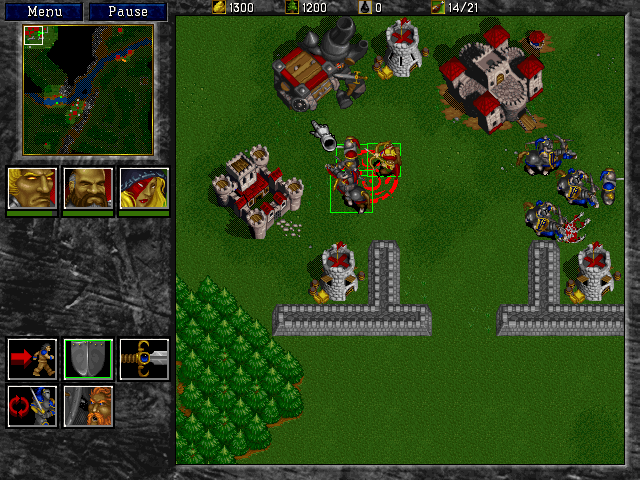
The Human Campaign
The human campaign in Beyond the Dark Portal is… okay. It’s a perfectly cromulent Warcraft 2 campaign, a step up from Tides of Darkness, while not being as weirdly written as the orc campaign. It holds relatively well together.
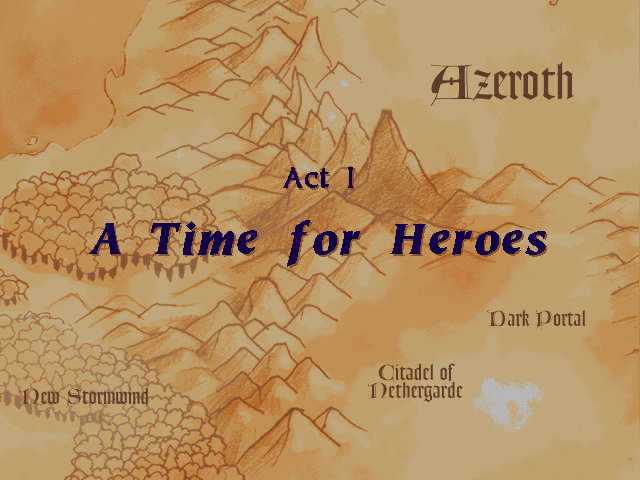
-
“Lord Khadgar, Keeper of the Eternal Watch and master of the mystic Citadel of Nethergarde”2, has sensed a dark power from the rift. Alleria, an elven ranger, is tasked with gathering reinforcements near New Stormwind, including the mercenary captain Danath and the paladin Turalyon.
On the surface, this looks like it will be a straightforward baseless mission. However, it includes a puzzle element. Danath is found on the same landmass as Alleria, but to reach Turalyon and Stormwind Keep, you need to cross the river on transport ships, which you can only build at a shipyard. There is a shipyard and some farms that come under your control later, as well as some peasants. They can’t build anything, nor can they gather gold, as there’s no town hall on the map. However, they can gather lumber, which you will have to do to build the ships. You also have to find enough farms across the map to go into food surplus and actually be able to build the ships.
This campaign’s designers tried to bring as much variety to the missions as the Warcraft 2 engine allows, and it shows.
Incidentally, Alleria has the dubious honor of being the only female character to appear in gameplay in all of Warcraft 2. Warcraft 1 had two of them — Garona and Griselda, though Garona used generic male orc voice lines and Griselda was an enemy. Alleria is, as far as I know, the first character to receive female voice acting in a Warcraft game.
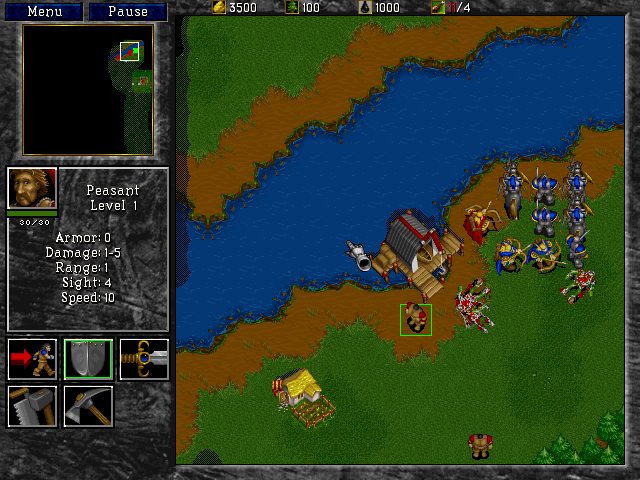
-
Orcs have reconstructed the Dark Portal and now hold Nethergarde under siege. Destroy them. A straightforward “establish a base, destroy anyone” mission. This map’s geography is very similar to that of the orc mission where you emerge from the Dark Portal, which is a nice touch. The main difference is that most of the map is under orc control here.
-
The Alliance High Command has approved a counterattack on the Dark Portal, but Khadgar believes that if it can be captured rather than destroyed, they can learn of the purpose of this new orc offensive. Another straightforward conquest mission, this time with water. Its geography is a throwback to the final human mission in Tides of Darkness, with the Portal on an island, but this time, there is only one connected body of water and so there’s no juggling multiple shipyards on different ends of the land.
Unfortunately, past this point you’re not going to see any visual variety in the tilesets. Tides of Darkness had three tilesets (winter, dirt, and grassland), but for the entire remainder of this campaign, we’re only going to see the fourth tileset added in Beyond the Dark Portal, because the rest of the campaign takes place on…
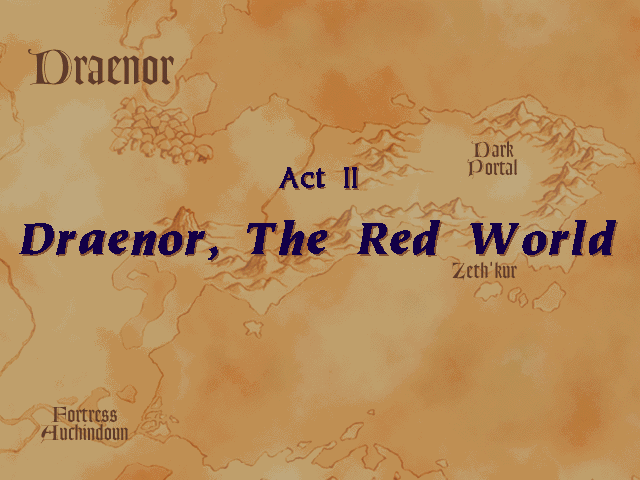
-
While you were busy capturing the Portal, Ner’zhul’s death knights robbed the Royal Library of New Stormwind, making off with the Book of Medivh. Which they… brought to Draenor through the Dark Portal under Alliance control, somehow? It’s confusing.
Apparently in the human campaign’s timeline, the Book of Medivh was the only artifact Ner’zhul needed on the human world for his portal plan, and there was no wanton destruction and continent-hopping involved: his lackeys just grabbed the book and left. Already this is a far more sensible setup than the orc campaign had.
Anyway, the High Command believes the only good response is to follow the Horde to Draenor and end its threat there. Carthago delenda est. Even if the premise is still stupid, because somehow the Alliance knows Ner’zhul wants to invade multiple other worlds (guess they peeked into that copy of the script he has) and somehow they believe invading them will strengthen the Horde with plunder instead of further exhausting its already halved strength.
The mission is sweet. You start with an army and peasants, having just emerged from the Portal on the other side, and a lone flying machine highlights a good location for your base. Remember that Alliance fortress that still overlooks the Dark Portal to this day? This is the mission where you build it. From scratch.
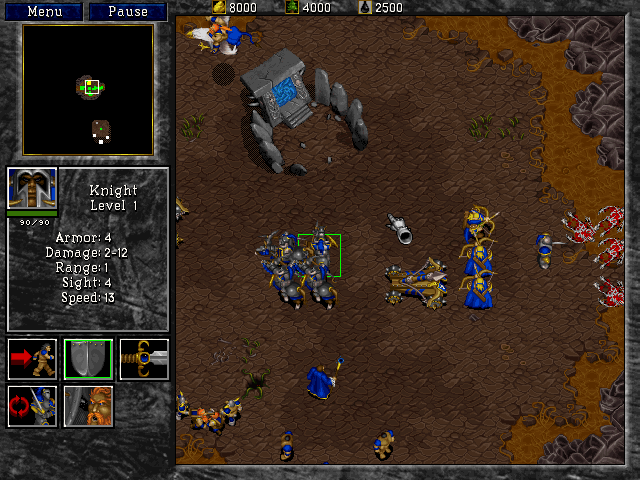
-
In the next mission, you establish naval supremacy over the seas of Draenor. Build three shipyards, destroy all orc shipyards at Zeth’kur. This campaign encourages faster-paced gameplay that emphasizes going straight for the stated mission objectives instead of trying to win the usual way by defeating all enemies, and it’s definitely the case here. Even the mission briefing tells you to be daring and swift.
-
The gryphon rider Kurdran has located the hidden Forthress Auchindoun, which Alleria suspects will be used for staging a new offensive against Azeroth. You must raze the fortress swiftly and retreat before the enemy can retaliate.
This mission is quick if you know what to do and frustrating if you don’t. Despite the mission briefing, you don’t actually have either Kurdran or Alleria here. Instead, you have Turalyon and Danath and some starting troops. Your objective is to destroy the orange player (the Bleeding Hollow clan) and bring Turalyon and Danath to your starting location. The quickest way to win is to immediately send your starting army to the orange player’s location (which you have to know beforehand or discover), raze their base, then retreat before the other orc players overwhelm you.
Again, the mission encourages you to be swift and daring, but doesn’t force you to. You can still win the traditional way by building a base, it’s just harder.
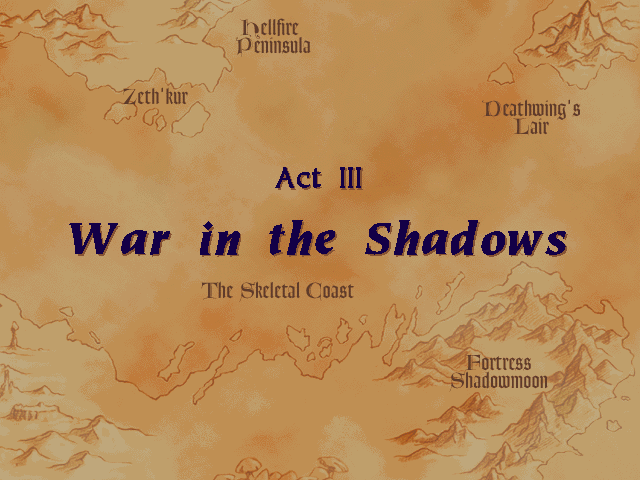
-
Kurdran and his gryphon Sky’ree were somehow captured in the assault on Auchindoun despite not even being present in that mission. Examining the ruins of the fortress, Khadgar learned the location of both the Book of Medivh and the Skull of Gul’dan, which he believes he can use together to destroy the Dark Portal for good and seal the rift between the two worlds.
The Skull of Gul’dan is located in the lair of the great dragon Deathwing, whose lair lies on a mountainous island, so that’s where your path lies next. You have Khadgar and Alleria and a very small army, but can rescue some captives from the Second War meant as sacrifices for Deathwing, including peasants to let you build a base. Kurdran is rescuable too.
There are orc bases on this map, but since your only objective is Deathwing (a very powerful dragon unit) and his lone dragon roost surrounded by winding mountain paths that are in places too narrow to walk through, there is a variety of ways to beat this mission.
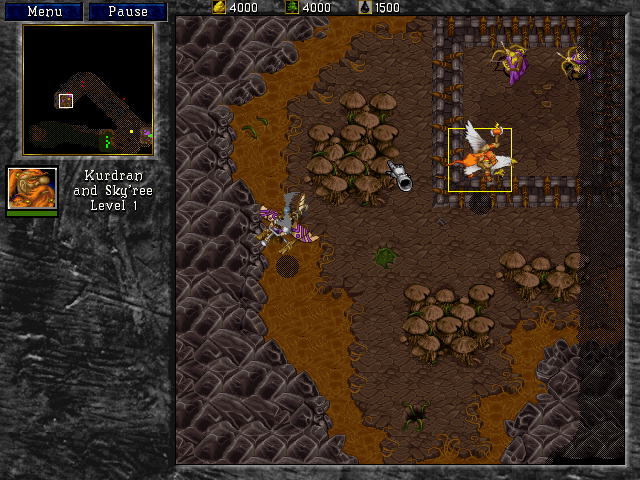
-
Next is a naval battle on the Coast of Bones, where an orcish armada is amassing. This is a Tides of Darkness style “destroy all enemies on an islands map” mission, except to build your base, you have to raze the weaker of the enemy bases first.
-
Finally, you assault the heavily fortified Fortress Shadowmoon in a bid to end Ner’zhul and recapture the Book of Medivh. Of course, the story can’t possibly end here, since the orc campaign had twelve missions and the human one has only had nine so far…
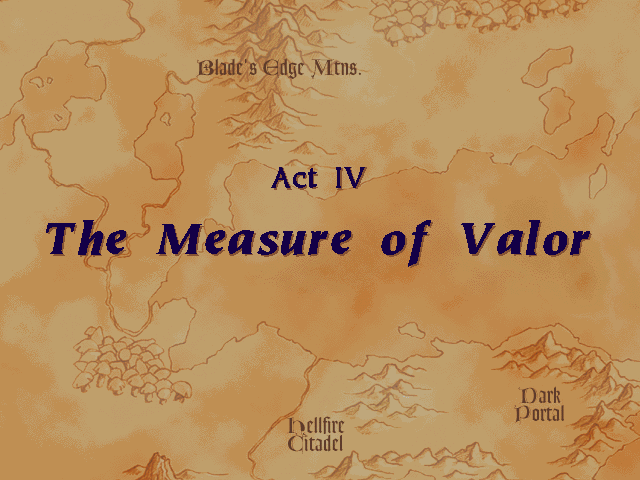
-
…Just as could be expected, the princess, or rather Ner’zhul, is in another castle, and so is the Book of Medivh. Furthermore, the orcs have laid siege to your fortress near the Dark Portal, and this mission is devoted to lifting the siege.
Although the objective states “Hold out until the besieging Orcs retreat”, this is not a survival mission as could be expected. Warcraft 2 simply doesn’t support survival missions the way Starcraft and Warcraft 3 do. While there is a trigger that’s supposed to award victory if every computer player is down to 400 gold or less, because of a bug it doesn’t actually fire, so your only option is to go out of your very sizable and well-fortified base and destroy all enemies.
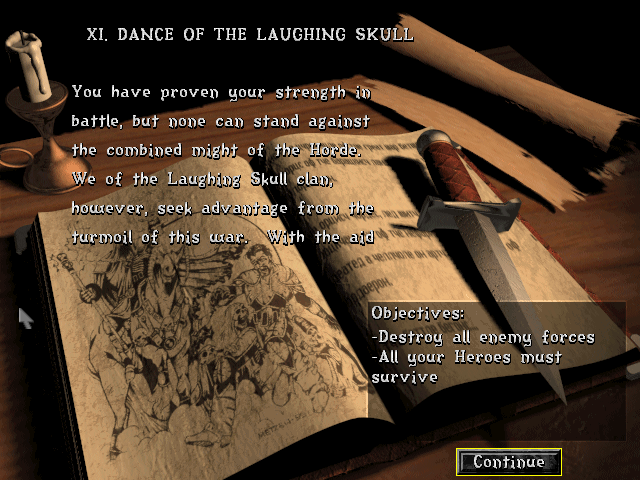
-
Next is a very unique mission. The Laughing Skull clan, which you’ve faced before, has apparently sensed where the wind is blowing and is willing to betray the Horde and give you the Book of Medivh (which they seized from Fortress Shadowmoon before you destroyed it) if you help them take the Blade’s Edge Mountains from the Thunderlord clan.
This is basically an orc mission, even though it’s part of the human campaign. You have Khadgar, Alleria, Turalyon and two paladins (which you can’t replace, so they and Turalyon are a valuable source of healing), and the rest is all orc units. You soon walk into a yellow orc base that comes under your control, and the rest of the mission is orcs versus orcs.
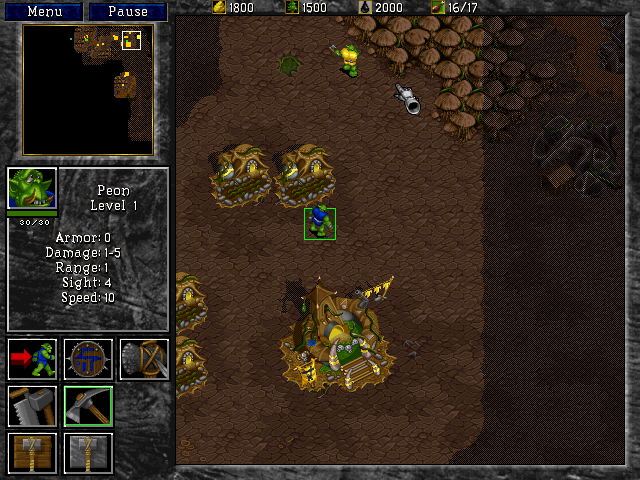
-
While you were retrieving the Book of Medivh, Ner’zhul opened massive dimensional rifts tearing Draenor apart and disappeared into one of them with his followers. Khadgar now has to close the Dark Portal from the Draenor side, with the help of both the Book and the Skull of Gul’dan, so that Draenor’s destruction doesn’t bring down Azeroth with it as well.
You have all five of your heroes some distance away from your base, which is under siege by a truly massive wave of orcs. The Dark Portal is actually inside your fortifications, but only Khadgar can damage it, and he does it very, very slowly. This mission is thus effectively a survival mission where you protect Khadgar with everything you’ve got while he slowly chips away the Portal’s health. All four other heroes are expendable; this is the only mission where you don’t have to keep them alive, since this is their last stand on a doomed world.
Finale
We’re shown a cinematic of Khadgar destroying the Dark Portal. Again. Only this time he does it properly.
As the flames die to embers and the arcane energies that once bound two worlds slowly fade, the Dark Portal crumbles into dust as its powers subside and dissolve. The finality of what has been done here becomes manifest. The moment is shattered as volcanoes erupt in fiery fury as the earth begins to shake beneath your feet. The world of Draenor is dying…
Khadgar motions toward the remaining rifts created by Ner’zhul and beckons you to follow him. The warriors of Azeroth under your command gaze upon the rifts with uncertainty - but to remain would be suicide. Knowing that their beloved Azeroth is safe from harm, they gather up weapons and wounded companions alike as you lead them into the swirling, unknown reaches of the Twisting Nether.
So Draenor is about to explode and we’re probably never going to see it again in any future Warcraft story. The good news, however, is that the Dark Portal, which was simply closed at the end of Tides of Darkness, is now super-duper-mega-closed and isn’t getting reopened, ever. The Alliance Expedition survives by leaving Draenor, and we’ll probably encounter it again on one of those wondrous, exciting unknown worlds out there that we’re yet to see.3
The camera also ominously focuses on the Skull of Gul’dan as it falls to the ground. I sure wonder what will become of it.
Final Thoughts
I admit I don’t hate this campaign. The plot holds together, and while the characters don’t really have personalities, the limitations of Warcraft 2’s mission format don’t really lend themselves to giving them personalities anyway.
If Warcraft 1 caught people’s interest in Blizzard, Warcraft 2 catapulted the company to fame and fortune. It’s not hard to see why. It improves on its predecessor in every aspect, effectively making it obsolete. It has aged better, and it’s still played competitively.
But…
How many people who played Warcraft 2 in childhood actually remember its story?
Warcraft 2’s gameplay and story aren’t integrated. They exist in different dimensions. Most of the background lore is in the manual, and if you don’t have it, you won’t understand who any of the characters are. The story is told between missions, while the time spent playing the missions themselves is essentially story-free. The story is also hamstrung, especially in the orc campaign in Beyond the Dark Portal, by the need to justify RTS gameplay that in the end retains the same basic beats from mission to mission. As Shogganosh said in the forum thread about this series:
I see this expansion as emblematic of Blizzard’s teething pains as it struggled to transition from just making games with a little story as a backdrop to creating character-centric stories that are just as important as the gameplay, since it’s apparent that Beyond the Dark Portal wanted to be a story about a roster of heroes/villains for the Alliance and Horde, but the RTS gameplay about building bases and armies held it back and they hadn’t figured a way around it yet.
It might be worth thinking of Starcraft as a Warcraft 2.5 in this regard, where they managed to blend RTS gameplay and a character-focused story without stumbling into the same problems, before Warcraft 3 came out and they managed to make an RTS that revolved around a cast of main characters in terms of story and gameplay alike.
If our goal was to examing the evolution of gameplay and story integration in Blizzard RTS games, then looking at Starcraft, the evolutionary link between Warcraft 2 and Warcraft 3, would be the obvious thing to do next. However, this series is about Warcraft, so I’ll only talk about Starcraft in passing, insofar as its design ideas were iterated on in subsequent Warcraft games.
What’s Next?
It seems that after Warcraft 2, Blizzard decided to retool their creation from a warfare setting into an adventure setting. As Shogganosh notes above, the Beyond the Dark Portal story wanted to be about heroes and their individual efforts, but was held back by the RTS format. I would say it was also held back by the setting itself as it existed at that point.
Warfare stories and adventure stories aren’t told in a vacuum, and you can’t easily tell one kind of story in a world designed for the other. So next time, I’ll take a break from talking about specific games, and instead examine the implicit assumptions, the difference in buy-in and worldbuilding principles between warfare settings and adventure settings, and the problems this difference caused for the long-term evolution of Warcraft.
And after that? The Game that Never Was.
-
What’s worse, the patterns are inconsistent. Why is kaldorei written without an apostrophe, but sin’dorei with one? Why is alara’shinu written with an apostrophe but Elune-adore with a hyphen, and ande’thoras-ethil with both? Is there a method to this madness or are the writers just making it up as they go along? ↩
-
Try to fit that on a business card. ↩
-
None of this is true, of course. ↩
Leave a Comment